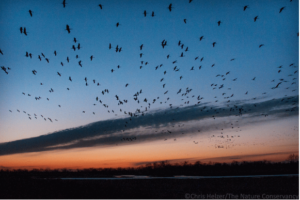Mary Grudgingly Admires Birds
This post was written by Mary Parr, one of Hubbard Conservation Fellows. Mary is an excellent botanist and land steward and very interested in the field of ecological restoration. She (along with Chelsea) is entering the final month of her Fellowship, which seems hard to believe.

The Central Flyway passes through our Platte River Prairies, bringing big flocks of geese, cranes (shown here), and numerous other bird species during the spring and fall.
Over the years, I have tried to foster an interest in birds, but have had little success. I prefer my deeply rooted photosynthetic friends that don’t flee from me when I slowly sieve through a field guide identifying them. While my relationship with birds has been strained by their elusiveness, I am beginning to understand why they receive praise from millions of bird lovers. Living on the Platte River Prairies, we are located directly in the continent’s central fly-way for migratory birds and water fowl. Since beginning the fellowship, I have seen and experienced the most birds (possibly) in my entire life. As a result, I have begun to develop curiosities about a specific behavior and one that I have now experienced by the thousands: flocking.
I can recall the first time I experienced a central fly way migration. One blue-skied spring morning, I woke up to a cacophony of honking. I went out the front door in my pajamas to view a river of Snow Geese in the sky. The continuous stream of birds’ silhouettes directly overhead stretched form horizon to horizon. Their movements reminded me of water flowing through a delta as their V’s were converging, diverging, and re-emerging. As I researched further why migration occurs in large flocks, I found there were many beneficial reasons. A big one is for safety. Many eyes provide many alarms when a predator is nearby. Additionally, it is more difficult for a predator to focus in and single out an individual – this is especially beneficial for young and old birds that may be more vulnerable. The V’s are an efficient form of travel reducing drag from the wind like bicyclists in the Tour de France. The front bird creates an updraft of air for the bird behind it, and the pattern continues down the V. This enables the group to use less energy and reduce fatigue. When the leader tires, they all alternate positions. The honking can be related to several communications, but my favorite is encouragement. Individuals from the back of the group will honk in support of the birds in the front to continue the pace. I like to think of a nervous young adult goose finally getting their big chance as the leader and their friends and parents cheering them on.
The Sandhill cranes migrate with similar behavior, but slightly different physics. Their bodies are shaped like an intercontinental airbus – perfect for gliding. By waiting patiently for the predominant winds to go the direction of their travel, they can travel long distances and expend little energy. My favorite group display of the Sandhill cranes was their angelic thermal rising during their departure from the Platte River this spring. The group takes advantage of thermal cells, pockets of rising warm air that are heated at the earth’s surface from the sun’s radiation. As the air rises (as warm things do because they are less dense) the cranes catch the updraft with their large wings. The slow rising occurs as a group in a long spiral and continues until they are hundreds of feet high and nearly out of sight. Once they reach the predominant winds above they are carried north to complete their journey to Canada, Alaska, and for some Siberia.
Although non-native, one of my favorite displays is from the European Starling – a species introduced from Europe in the 1880s. Every fall growing up I would sit utterly mesmerized as I watched the large swarming mass of hundreds of birds expanding and contracting, twisting and pulsating in perfect coordination. These starlings are widely known for their fluid flocking displays known as murmurations. This mass avian aerial stunt occurs every fall, primarily in urban areas and cities where the starlings predominately live. They gather for many reasons including: to share information, body heat, and avoid predators – the primary one being Peregrine falcons. The presence of a predator in the sky results in even wilder displays as the group twists and diverts the path of the raptor. These birds are not led by a determined leader, but governed collectively by all the members. Among all bird species, starlings flocks are particularly recognized for their excellent communication and collective response. When one individual changes speed or direction, its immediate flock mates will respond to the change almost simultaneously. Some research has found that an individual in the flock can continuously monitor up to 7 of its nearest neighbor’s movements and react respectively. The swooning flocks in Denmark are so dense they actually block out the sun in a display known as “Black Sun”. The largest flock recorded had over 6 million individuals!
While birds are not the champion of my interests, I can respect a good show when I see one. Happy flying, my friends.
Originally posted in the Prairie Ecologist.


